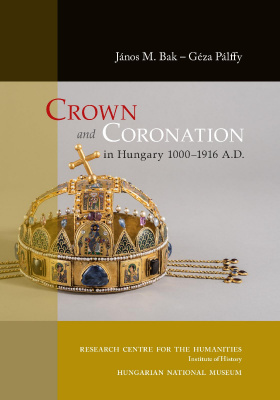An English-language monograph on the history of the Holy Crown of Hungary and the Hungarian coronations
As part of the academic work of the “Momentum” Holy Crown Research Group, a detailed monograph in English on the history of the Holy Crown and Hungarian coronations written by the renowned (and, sadly, recently deceased) professor of medieval studies János M. Bak, together with Research Professor at the Institute of History Research Centre for the Humanities and leader of the Research Team Géza Pálffy, has just been published.
The book of János M. Bak and Géza Pálffy represents the first international summary work on the topic ever published. The cover of the volume, entitled Crown and Coronation in Hungary 1000–1916 A.D., may be viewed here with preliminary pages viewable here.

As with several other publications of the “Momentum” Research Group, this latest volume has been released as a joint publication of the and the Institute of History and Hungarian National Museum, trusted guardian for this day of the Hungarian Coronation Mantle. The 264-page volume, illustrated with more than 100 colour figures, contains the most recent research on the origin and the adventure-filled history of the Holy Crown and the coronations of Hungarian kings and queens from St Stephen (1000–38) up to the reign of Charles IV (1916–18). The scholarly but popular monograph starts with the history of succession to the Hungarian throne, discusses the locations and dates of the various inaugurations and their ecclesiastical and secular ceremonies, as well as the main protagonists involved, and finally presents the coronation insignia, tracking in detail the vicissitudes of the Holy Crown from the Middle Ages to the twenty century, building, in part, on the research team’s own Hungarian-language collection of studies, now in its second edition. In contrast to previous treatments of the subject, besides the classic coronation insignia, this volume also pays particular attention to the often overlooked ecclesiastical and occasional paraphernalia of ceremonies (crosses, flags, batons, coins, etc.), linking these to the research team’s other recently published monographs and catalogues on the topic.
The authors address an intelligent lay readership, but believe that foreign historians, art historians and university students will also peruse the volume with profit. No similar overview of all aspects of the subject has hitherto been published in English, as the English-language volumes of Éva Kovács and Zsuzsa Lovag (1988) and Endre Tóth and Károly Szelényi (1996) focused primarily on the coronation insignia themselves and on their relationship to the history of art. Past scholars have been studying Hungarian national jewels for several centuries, and building on these studies, János M. Bak and Géza Pálffy now share the research findings of the past quarter century with an international readership. The beautiful design and layout of the A/5 hardcover publication is a product of the exceptional work of Judit Borbély and Krisztina Bertók of Budapest.
The price of the volume is HUF 4,000, or EUR 15, if bought through international distributors. It can be purchased or ordered from the Institute of History Research Centre for the Humanities, (Budapest, H-1097 Tóth Kálmán u. 4, B 4/44; tel.: 00 36 1 224 67 00/4624, ext. 4626; email: bardi [dot] erzsebet [at] btk [dot] mta [dot] hu; terjesztes [at] btk [dot] mta [dot] hu), or from Hungarian and foreign distributors.
